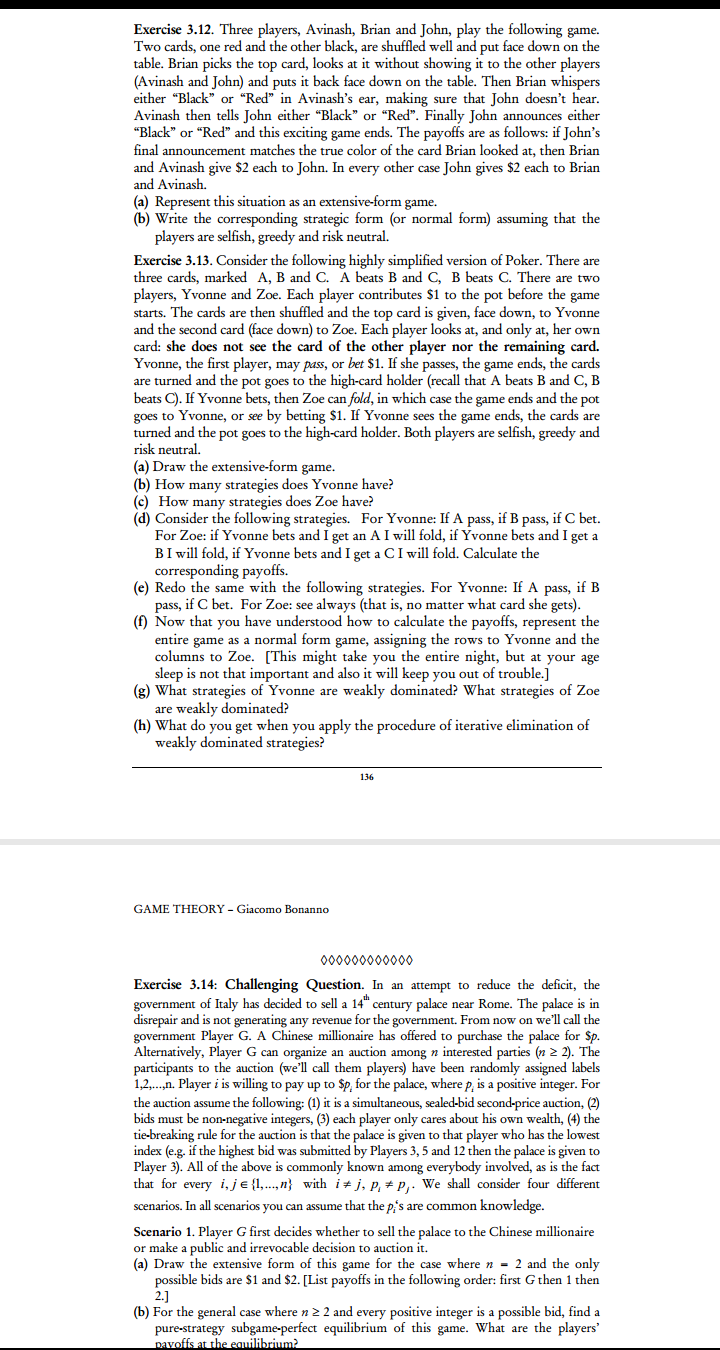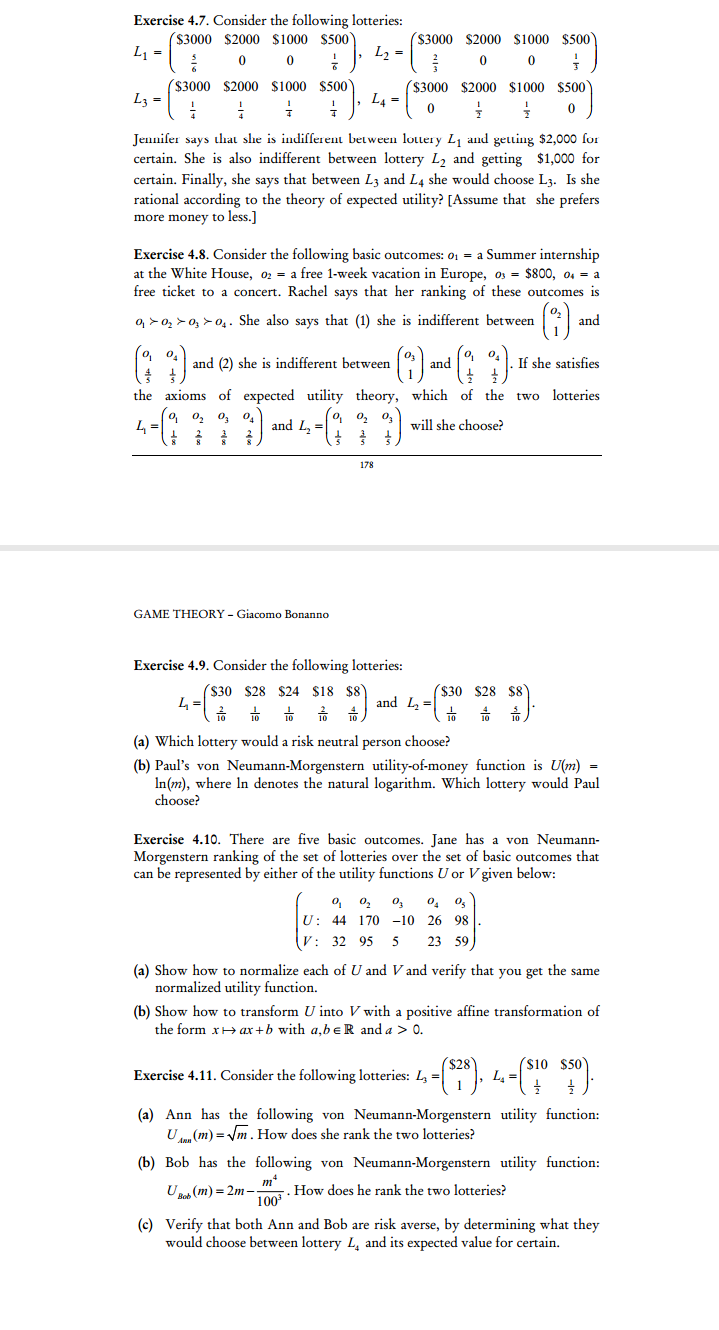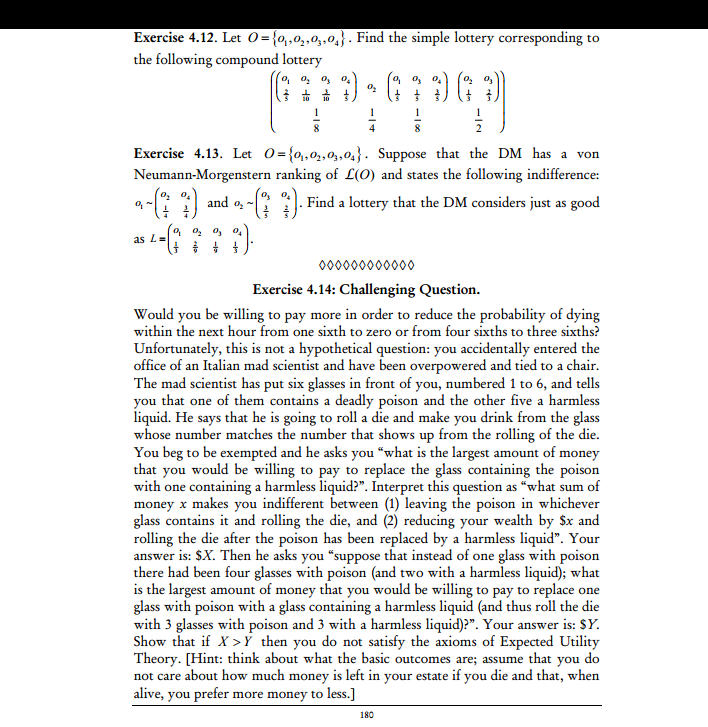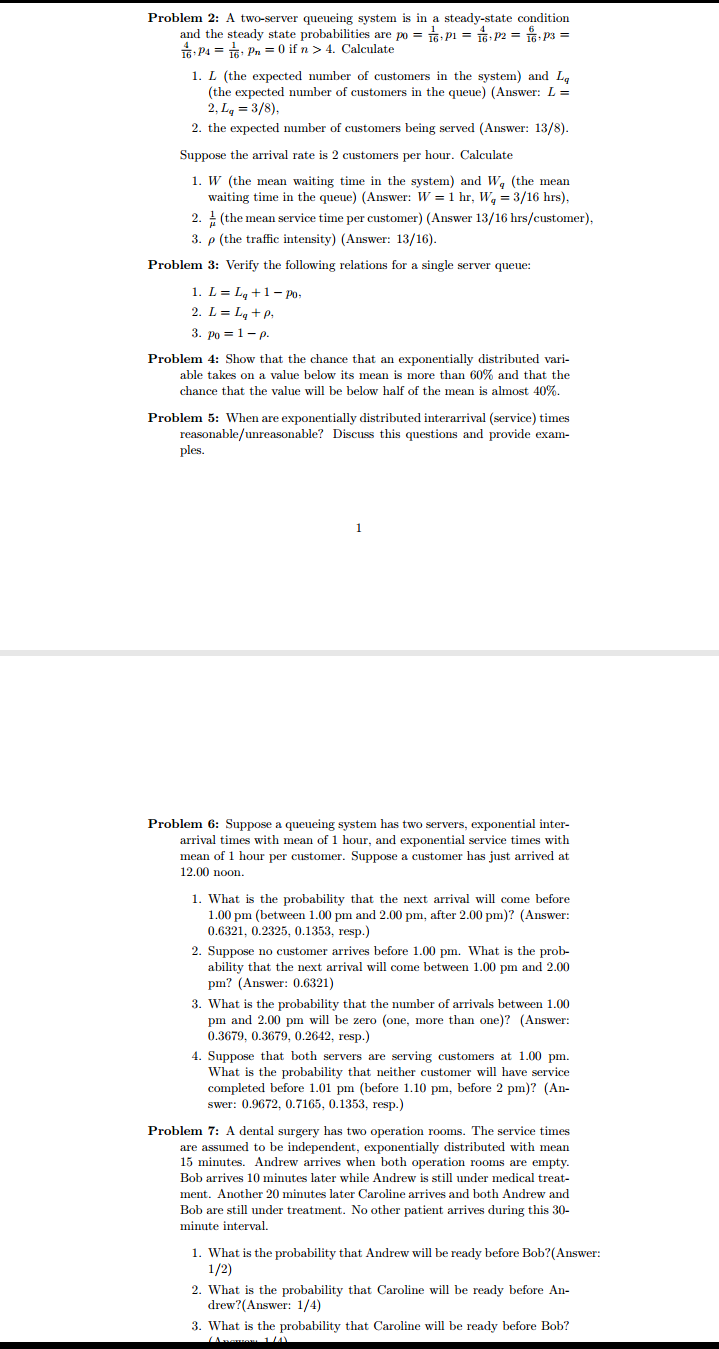



solve all parts have not been understanding it, precise answers with explanations on how to arrive at the answer please
Exercise 3.12. Three players, Avinash, Brian and John, play the following game. Two cards, one red and the other black, are shuffled well and put face down on the table. Brian picks the top card, looks at it without showing it to the other players (Avinash and John) and puts it back face down on the table. Then Brian whispers either "Black" or "Red" in Avinash's ear, making sure that John doesn't hear. Avinash then tells John either "Black" or "Red". Finally John announces either "Black" or "Red" and this exciting game ends. The payoffs are as follows: if John's final announcement matches the true color of the card Brian looked at, then Brian and Avinash give $2 each to John. In every other case John gives $2 each to Brian and Avinash. (a) Represent this situation as an extensive-form game. (b) Write the corresponding strategic form (or normal form) assuming that the players are selfish, greedy and risk neutral. Exercise 3.13. Consider the following highly simplified version of Poker. There are three cards, marked A, B and C. A beats B and C, B beats C. There are two players, Yvonne and Zoe. Each player contributes $1 to the pot before the game starts. The cards are then shuffled and the top card is given, face down, to Yvonne and the second card (face down) to Zoe. Each player looks at, and only at, her own card: she does not see the card of the other player nor the remaining card. Yvonne, the first player, may pass, or bet $1. If she passes, the game ends, the cards are turned and the pot goes to the high-card holder (recall that A beats B and C, B beats C). If Yvonne bets, then Zoe can fold, in which case the game ends and the pot goes to Yvonne, or see by betting $1. If Yvonne sees the game ends, the cards are turned and the pot goes to the high-card holder. Both players are selfish, greedy and risk neutral. (a) Draw the extensive-form game. (b) How many strategies does Yvonne have? (c) How many strategies does Zoe have? (d) Consider the following strategies. For Yvonne: If A pass, if B pass, if C bet. For Zoe: if Yvonne bets and I get an A I will fold, if Yvonne bets and I get a B I will fold, if Yvonne bets and I get a C I will fold. Calculate the corresponding payoffs. (e) Redo the same with the following strategies. For Yvonne: If A pass, if B pass, if C bet. For Zoe: see always (that is, no matter what card she gets). (f) Now that you have understood how to calculate the payoffs, represent the entire game as a normal form game, assigning the rows to Yvonne and the columns to Zoe. [This might take you the entire night, but at your age sleep is not that important and also it will keep you out of trouble.] (g) What strategies of Yvonne are weakly dominated? What strategies of Zoe are weakly dominated? (h) What do you get when you apply the procedure of iterative elimination of weakly dominated strategies? 136 GAME THEORY - Giacomo Bonanno 000000000000 Exercise 3.14: Challenging Question. In an attempt to reduce the deficit, the government of Italy has decided to sell a 14" century palace near Rome. The palace is in disrepair and is not generating any revenue for the government. From now on we'll call the government Player G. A Chinese millionaire has offered to purchase the palace for $p. Alternatively, Player G can organize an auction among n interested parties (n 2 2). The participants to the auction (we'll call them players) have been randomly assigned labels 1,2,..,n. Player i is willing to pay up to $p, for the palace, where p, is a positive integer. For the auction assume the following: (1) it is a simultaneous, sealed-bid second-price auction, (2) bids must be non-negative integers, (3) each player only cares about his own wealth, (4) the tie-breaking rule for the auction is that the palace is given to that player who has the lowest index (e.g. if the highest bid was submitted by Players 3, 5 and 12 then the palace is given to Player 3). All of the above is commonly known among everybody involved, as is the fact that for every i, jell, ...,") with i * j, p, # p, . We shall consider four different scenarios. In all scenarios you can assume that the p,'s are common knowledge. Scenario 1. Player G first decides whether to sell the palace to the Chinese millionaire or make a public and irrevocable decision to auction it. (a) Draw the extensive form of this game for the case where n = 2 and the only possible bids are $1 and $2. [List payoffs in the following order: first G then 1 then 2.] (b) For the general case where n 2 2 and every positive integer is a possible bid, find a pure-strategy subgame-perfect equilibrium of this game. What are the players' payoffs at the equilibrium?Exercise 4.7. Consider the following lotteries: $3000 $2000 $1000 $500 $3000 $2000 $1000 $500 L1 = L, = WIN $3000 $2000 $1000 $500 $3000 $2000 $1000 $500 L; = LA I 0 Jennifer says that she is indifferent between lowery 1 and getting $2,000 for certain. She is also indifferent between lottery Ly and getting $1,000 for certain. Finally, she says that between Ly and L4 she would choose Ly. Is she rational according to the theory of expected utility? [Assume that she prefers more money to less.] Exercise 4.8. Consider the following basic outcomes: 01 = a Summer internship at the White House, oz = a free 1-week vacation in Europe, or = $800, or = a free ticket to a concert. Rachel says that her ranking of these outcomes is 0 > 02 > 0) > 04 . She also says that (1) she is indifferent between (") and s and (2) she is indifferent between (") and 2 3 . If she satisfies the axioms of expected utility theory, which of the two lotteries will she choose? 178 GAME THEORY - Giacomo Bonanno Exercise 4.9. Consider the following lotteries: I = $30 $28 $24 $18 $8 $30 $28 $8 and Lz = To To (a) Which lottery would a risk neutral person choose? (b) Paul's von Neumann-Morgenstern utility-of-money function is U(m) = In(m), where In denotes the natural logarithm. Which lottery would Paul choose? Exercise 4.10. There are five basic outcomes. Jane has a von Neumann- Morgenstern ranking of the set of lotteries over the set of basic outcomes that can be represented by either of the utility functions U or V given below: U: 44 170 -10 26 98 V: 32 95 5 59 (a) Show how to normalize each of U and V and verify that you get the same normalized utility function. (b) Show how to transform U into V with a positive affine transformation of the form xi arth with a, be R and a > 0. Exercise 4.11. Consider the following lotteries: L, = ($28 ), L. = + + (a) Ann has the following von Neumann-Morgenstern utility function: Umm(m) = Vm . How does she rank the two lotteries? (b) Bob has the following von Neumann-Morgenstern utility function: U Bob (m) = 2m-- m" 1003 . How does he rank the two lotteries? (c) Verify that both Ann and Bob are risk averse, by determining what they would choose between lottery L, and its expected value for certain.Exercise 4.12. Let 0: {mayoral}. Find the simple lottery corresponding to the following compound lottery eaten. worsen. 1J..1J.a!J.J.1J.J. 5Il5 51-5 3! l E 1 l l a 4 2 Exercise 4.13. Let U={o.,ol,og,o4}. Suppose that the DM has a tron Neumann-Morgenstern ranlsing of 110} and states the following indifference: til-"[5: 1'] and 4'11 \"[4\Problem 2: A two-server queueing system is in a steady-state condition and the steady state probabilities are po = 16: P1 = 16 : P2 = 16 . P3 = 16 : P4 = 16: Pn = 0 if n > 4. Calculate 1. L (the expected number of customers in the system) and Lo (the expected number of customers in the queue) (Answer: L = 2, Liq = 3/8). 2. the expected number of customers being served (Answer: 13/8). Suppose the arrival rate is 2 customers per hour. Calculate 1. W (the mean waiting time in the system) and W, (the mean waiting time in the queue) (Answer: W = 1 hr, W, = 3/16 hrs), 2. - (the mean service time per customer) (Answer 13/16 hrs/customer), 3. p (the traffic intensity) (Answer: 13/16). Problem 3: Verify the following relations for a single server queue: 1. L = Lq + 1 -Po. 2. L = Lq + P. 3. po = 1 - p. Problem 4: Show that the chance that an exponentially distributed vari- able takes on a value below its mean is more than 60% and that the chance that the value will be below half of the mean is almost 40%. Problem 5: When are exponentially distributed interarrival (service) times reasonable/unreasonable? Discuss this questions and provide exam- ples. Problem 6: Suppose a queueing system has two servers, exponential inter- arrival times with mean of 1 hour, and exponential service times with mean of 1 hour per customer. Suppose a customer has just arrived at 12.00 noon. 1. What is the probability that the next arrival will come before 1.00 pm (between 1.00 pm and 2.00 pm, after 2.00 pm)? (Answer: 0.6321, 0.2325, 0.1353, resp.) 2. Suppose no customer arrives before 1.00 pm. What is the prob- ability that the next arrival will come between 1.00 pm and 2.00 pm? (Answer: 0.6321) 3. What is the probability that the number of arrivals between 1.00 pm and 2.00 pm will be zero (one, more than one)? (Answer: 0.3679, 0.3679, 0.2642, resp.) 4. Suppose that both servers are serving customers at 1.00 pm. What is the probability that neither customer will have service completed before 1.01 pm (before 1.10 pm, before 2 pm)? (An- swer: 0.9672, 0.7165, 0.1353, resp.) Problem 7: A dental surgery has two operation rooms. The service times are assumed to be independent, exponentially distributed with mean 15 minutes. Andrew arrives when both operation rooms are empty. Bob arrives 10 minutes later while Andrew is still under medical treat- ment. Another 20 minutes later Caroline arrives and both Andrew and Bob are still under treatment. No other patient arrives during this 30- minute interval. 1. What is the probability that Andrew will be ready before Bob?(Answer: 1/2) 2. What is the probability that Caroline will be ready before An- drew?(Answer: 1/4) 3. What is the probability that Caroline will be ready before Bob














